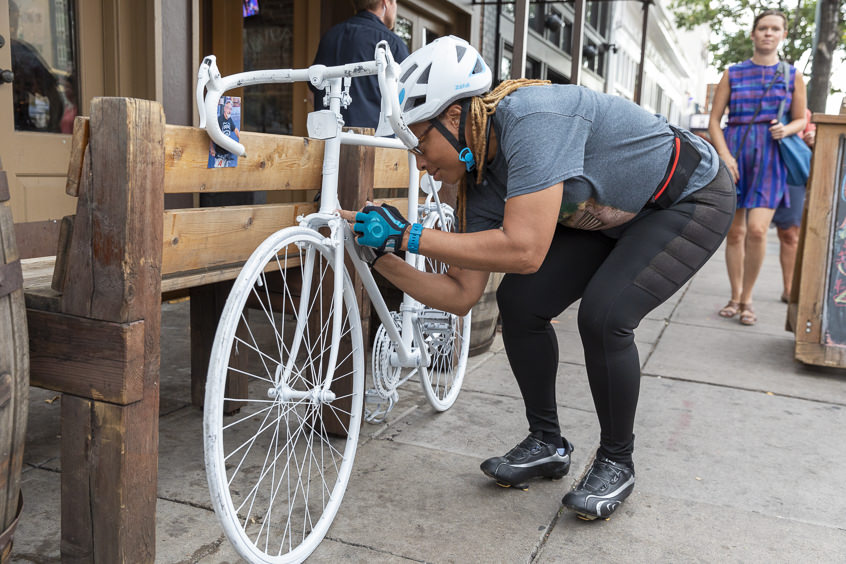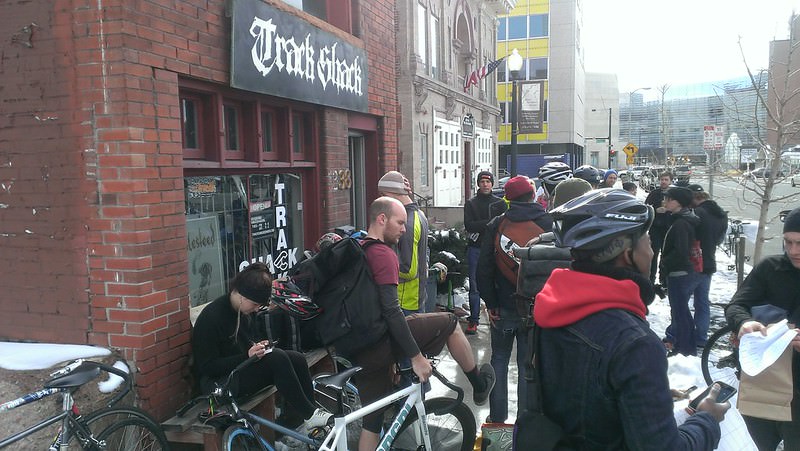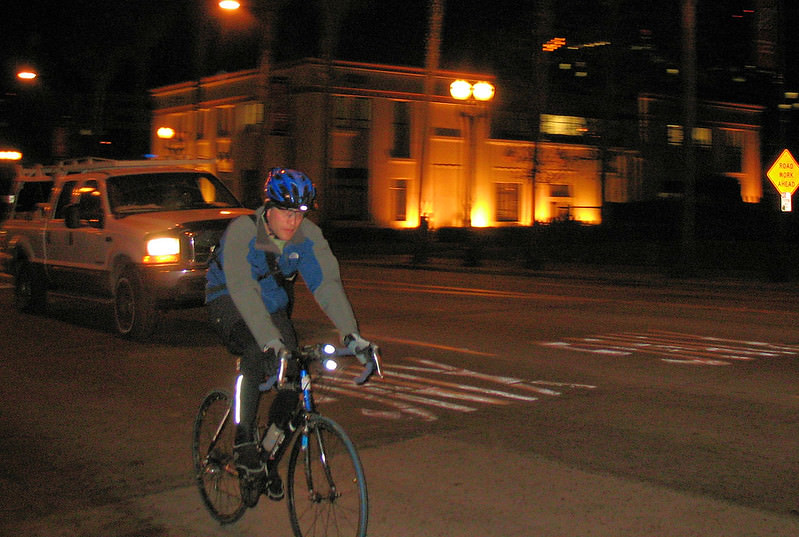victims for over 25 years.
Ghost Bikes and Bike Collisions in Denver
You’re driving through LoHi on your way to meet a friend for coffee at Black Eye, and you see an old bike, painted bright white, decorated with plastic flowers, locked to a stop sign at an intersection. If you didn’t know better, you might think that this was someone’s strange idea of a lawn decoration or guerilla public art. But what you’re seeing is a ghost bike, locked to the location where a fatal bicycle collision occurred.
Note: the cycling community encourages everyone to refer to collisions between cars and bikes as collisions rather than accidents, and because we feel strongly aligned with the cycling community, we wish to honor their request. This is why you’ll see us use “bicycle collision” rather than “bicycle accident” throughout this post.
What Is a Ghost Bike?

Leslie Blue signs a ghost bike dedicated to Scott Hendrickson. Photo: Andy Bosselman, from StreetsBlog Denver on Flickr.
While the ghost bike concept can be traced to an art installation in San Francisco in 2002, the first ghost bike erected as a memorial was in 2003, when a car hit and killed a cyclist in St. Louis. Since then, ghost bikes have appeared around the world, as cyclists and road safety advocates seek to bring more public awareness of bicyclist deaths. The ghost bike is a somber reminder to drivers to always look out for cyclists, and a plea for urban planners to design and build infrastructure that supports safer ways for cyclists, pedestrians, and cars to co-exist in cities.
Is Cycling in Denver Dangerous?

Photo of Denver cyclists by teakwood on Flickr.
Colorado is ranked 14th in the country for fatal bicycle collisions per capita, with an average of ten deaths a year. However, 2018 was one of the worst years in recent memory for bike and pedestrian fatalities: of the 61 traffic fatalities in Denver in 2018, 24 of those were bicyclists or pedestrians. And that’s just Denver alone, without taking into account the rest of the state.
With that said, thousands of people cycle safely in Denver every day. We have more than 80 miles of urban trails off the roads and numerous bike lanes, sharrows, and bike routes across the metro area. From Downtown Denver you can ride to Littleton, Lakewood, Golden, Boulder, Commerce City, Aurora, and other nearby cities, completely off the roads. The paths are relatively well maintained, even in winter, and are used by bike commuters, people training for long races, families, and folks just looking to have fun, leisurely pedaling on the weekends.
How Can I Be a Safer Cyclist?

A safe night rider. Photo by Richard Masoner on Flickr.
Cyclists can’t control whether or not drivers will be safe around them, but here are three ideas we have of things you can do to ride safer: be visible and protected, be aware, follow the rules.
Be Visible and Protected
As a cyclist, please ensure that you have bright front and rear lights for night riding; if a car hits you at night and you don’t have lights, the driver can argue that he or she didn’t see you and the collision is your fault. Wear reflective clothing or carry a pannier or backpack with reflective strips. In addition to being as visible as possible, please protect your head! Helmets reduce the risk of death in a crash by nearly 50%, and can also decrease the likelihood of serious brain injury if you do survive a car crash.
Be Aware
While bicycling Denver’s streets, never let your guard down. Make eye contact with drivers you encounter at intersections while changing lanes, and when merging with traffic. If you haven’t confirmed a driver can see you by making eye contact, assume they don’t. Just like driving, texting while on your bike is a terrible idea. Pull up your map on your smartphone ahead of time, and use a device that mounts it to your bike so you can use audio cues to get where you’re going. Also, while cycling home drunk from the bar may seem like a better idea than driving drunk, it is still incredibly dangerous and also illegal.
Follow the Rules
Some cyclists scoff at the idea of stopping at four-way stops, of waiting for a stoplight to turn green, or of riding on the streets rather than sidewalks. But many fatal bike collisions occur at intersections, to the fault of both drivers and cyclists. Being hyper-aware at intersections and following the rules of a four-way stop or stoplights can help the flow of traffic and increase your visibility. And while it may be tempting to ride on a sidewalk to skip heavy traffic, riding on sidewalks is not only against the law, but it can cause unexpected dangers for cyclists, especially when riding from the sidewalk onto the street or across an alley or driveway where cars do not expect to encounter you. If you’re injured when a car hits you but you’ve broken a traffic law, the driver isn’t at fault, and your injuries are entirely your own to bear. Also, learn your hand signals for right and left turns, and use them!
What If I’m in a Bike Collision in Denver?
Make sure you or witnesses call the police to the scene and collect the driver’s insurance and contact information. After seeking immediate medical care, call the O’Sullivan Law Firm for a free review of your case. Check out how we help bike collision victims in Denver and read more of our bicycle riding tips.
And next time you see a ghost bike in Denver, take a moment to look at your surroundings. If you’re a driver please be conscious of the dangers cyclists face on the streets, and if you’re a cyclist remember to be visible and protected, be aware, and follow the rules.
Free Consultation
Search For
Recent Articles
- Are all motorcycles created equal?
- Frequently Asked Questions about Personal Injury Attorneys
- How Do Personal Injury Attorneys Calculate Future Medical Expenses in a Car Crash Settlement?
- Ways to Increase Your Visibility When Riding Your Bicycle in Denver
- 5 Reasons to Hire a Personal Injury Attorney if a Loved One Is Injured
Categories
- Arvada
- Aurora
- Auto Accident eBook
- Auto Insurance
- Bicycle
- Bicycle/Motorcycle Accidents
- Bodily injury
- Car accidents
- Centennial
- Colorado
- Colorado Legislature
- community
- Concussion
- Denver
- distracted driving
- DUI Accidents
- Englewood
- Events
- Flood Insurance
- Fort Collins
- Highlands Ranch
- Hit and Run
- In The News
- insurance companies
- Lakewood
- Littleton
- Marijuana DUI
- Motorcycle Accidents
- Motorcycle Insurance
- Motorcycle Law eBook
- Motorcycles
- Newsletter
- Pedestrian
- Personal Injury Law
- Safe Driving
- Safety
- Scooters
- technology
- Thornton
- Tips
- Uncategorized
- vibrio vulnificus bacteria
- Videos
- Westminster
- Winter Driving
Archive
- March 2024
- February 2024
- January 2024
- December 2023
- November 2023
- October 2023
- September 2023
- August 2023
- July 2023
- June 2023
- May 2023
- April 2023
- March 2023
- February 2023
- January 2023
- November 2022
- September 2022
- April 2022
- March 2022
- February 2022
- January 2022
- December 2021
- November 2021
- October 2021
- September 2021
- August 2021
- July 2021
- June 2021
- May 2021
- April 2021
- January 2021
- December 2020
- November 2020
- October 2020
- September 2020
- August 2020
- July 2020
- June 2020
- May 2020
- April 2020
- March 2020
- February 2020
- January 2020
- December 2019
- November 2019
- October 2019
- September 2019
- August 2019
- July 2019
- June 2019
- May 2019
- March 2019
- February 2019
- January 2019
- December 2018
- November 2018
- October 2018
- September 2018
- August 2018
- July 2018
- June 2018
- May 2018
- April 2018
- March 2018
- February 2018
- January 2018
- December 2017
- November 2017
- October 2017
- September 2017
- August 2017
- July 2017
- June 2017
- May 2017
- April 2017
- March 2017
- February 2017
- January 2017
- December 2016
- November 2016
- October 2016
- September 2016
- August 2016
- July 2016
- June 2016
- May 2016
- April 2016
- March 2016
- February 2016
- January 2016
- December 2015
- November 2015
- October 2015
- September 2015
- August 2015
- July 2015
- June 2015
- May 2015
- April 2015
- February 2015
- December 2014
- November 2014
- October 2014
- September 2014
- July 2014
- June 2014
- May 2014
- April 2014
- March 2014
- February 2014
- January 2014
- October 2013
- October 2012
- September 2012
- August 2012
- July 2012
- February 2012
- August 2011
- March 2011
- October 2010